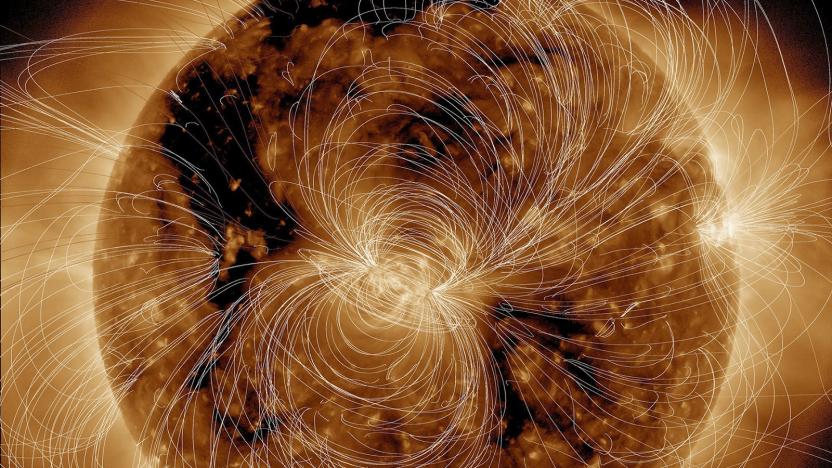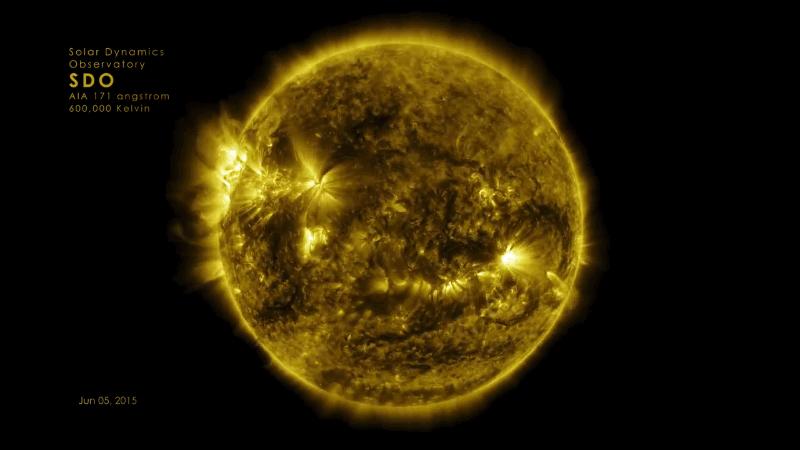SolarDynamicsObservatory
Latest

Just another day in our Sun's crazy magnetic life
Sunspots, flares and other solar activity show the sun's wild side, but we never see the massive forces that cause them. Now, scientists from NASA's Solar Dynamics Observatory (SDO) have created a visualization of the powerful magnetic fields that create havoc on the solar surface. They overlaid a computer-generated magnetic field onto a live image from August 16th, giving us a fuller picture of the sun's power and menace.

See the sun do a somersault, courtesy of NASA's observatory
NASA's Solar Dynamics Observatory took a photo of the sun every 12 seconds on July 6th, and the results aren't quite what you'd expect. A time-lapse video of the images makes it look like the sun is doing a somersault, because the SDO was spinning 360-degrees on one axis when it captured them. The observatory performs the seven-hour maneuver once a year to take an accurate measurement of the star's edge. See, the solar surface is pretty chaotic, and the spacecraft has tough time finding its outermost layer while it's stationary. SDO's images were taken in extreme ultraviolet wavelength, but NASA colorized the sun in the video below, so we can see it tumbling in space.

NASA films Mercury crossing the sun's surface
You don't have to wait for years to watch Mercury crossing the sun if you missed NASA's livestream earlier. The agency's Solar Dynamics Observatory has captured the planet's transit across the star's fiery surface on film and has even uploaded a time-lapse video of the images on YouTube. SDO is the same spacecraft NASA launched in 2010 to study the sun's magnetic field. The celestial event occurred on May 9th, from 7:12 AM to 2:42 PM Eastern, and it only happens around 13 times every century.

One-year timelapse video of the sun shows its dancing corona
NASA's Solar Dynamics Observatory was only designed to fly for five years, but it has celebrated six years of 24/7 solar observation on February 11th. The ultraHD video below the fold is a timelapse that stitches together images the spacecraft captured during that sixth year, from January 1st, 2015 to January 28th, 2016. Since each frame represents two hours and the photos were taken in extreme ultraviolet range, you can clearly see the sun's corona dancing and undulating throughout the video.

The Big Picture: Catching an intense solar flare in action
It's no longer rare to hear reports of solar flares that could affect Earth, but seeing them in vivid detail? That's another matter. Thankfully, NASA's Solar Dynamics Observatory recently captured a high-intensity X1.8 flare (80 percent more intense than an already huge X1 flare) in action. The pretty pyrotechnics you see above represent a subset of the ultraviolet light from the eruption, while the video below shows what it looked like in other wavelengths. And the kicker? As impressive as this may be, it's far from the largest example in recent memory -- that honor goes to a mammoth X28+ flare from 2003. These ejections aren't so enjoyable when they cause havoc with communications and navigation systems, but they at least make for a good light show.

Alt-week 9.8.12: Moon farming, self powered health monitors and bringing a 50,000 year-old girl to life
Alt-week peels back the covers on some of the more curious sci-tech stories from the last seven days. Some weeks things get a little science heavy, sometimes it's a little on their weird side, and there's usually a bit of space travel involved, but these week's trend seems to be "mind-blowing." Want to grow carrots on the Moon? We got you covered. How about bringing a 50,000 year-old ancient human back to life? Sure, no biggie. Oh but what about a solar eruption that reaches some half a million miles in height. We've got the video. No, really we have. Mind blown? This is alt-week.

Summer-loving NASA engineers launch SDO probe to worship the sun (video)
Say all you want about how bad your local forecast is, it's way more accurate than our local solar forecast. The last time we checked, solar storms are said to knock out GPS temporarily sometime in the next two years -- the kind of window that would make even the most suave meteorologist smirk. With the launch of the new Solar Dynamics Observatory we're hoping NASA can shrink that window down by, oh, at least a few months. The probe lifted off yesterday, perched atop an Atlas V rocket, and is now orbiting Earth. There it will study our sun with a series of optical and magnetic sensors, beaming data back at a rate of 150MBit/sec, making us ever so slightly jealous that this thing can get a better signal in space than we can down here on the surface. The launch fireworks are embedded below for those who weren't glued to NASA TV yesterday morning. [Thanks, Pavel]




